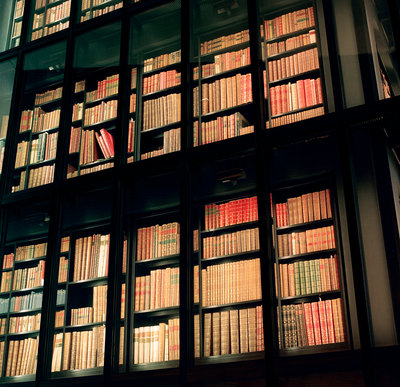 |
| Image retrieved from prints.bl.uk. |
In parts of the enormous London repository employees can hear the tube trains pass on the other side of the concrete wall when they make their rounds to retrieve books for readers from the closed stacks. The building is outfitted with a water collection mechanism to pump water away from the basement. The 15 year old building was one of the first national libraries built with preservation in mind, since part of the idea of the Copyright Act of 1911 was to maintain those works for future generations.
To access the library's materials, the user need only offer a name and address, and give some idea as to their research interests. Membership is not restricted to British citizens. Membership takes about thirty minutes to obtain. Check here for more information on obtaining a Reader's Pass.
Requests are then made at a terminal (or online) and the library's staff will retrieve the book within one hour and ten minutes. The materials are accessed through one of the libraries many subject specific reading rooms. You can also order books in advance of your visit.
 |
| Photo provided by Wikipedia user Fæ. |
The book tracking and transportation system is quite advanced, using barcodes to id books, the baskets they travel in, the location they are, and the location to which they are traveling. The ABRS (Automated Book Retrieval System) has an excellent track record, as they have never lost a book inside.
For the record, I had several wonderful photos of this system of my own that were tragically lost in a photo transfer. I'm glad I found these from the Wikipedia archives.
 |
| Photograph by Mike Peel (www.mikepeel.net). |
The collection is not subject indexed and there is no subject browsing. Readers must present a list of the items needed. Below, book locators decide where books are stored, primariliy in high and low usage categories. Books are cataloged with the Anglo American Cataloging Rules, but they are often ordered by size and date of reception.
This is the first national library I have had the pleasure to visit. It is obvious that the operations and goals of the library are ambitious, given the volume of works and the need to preserve the materials with all due care. However, I'm sure I will not be surprised to find that the BL is among the top national libraries in the world, while providing excellent item level preservation and really dedicated user access.
No comments:
Post a Comment